Social isolation and elderly's holistic development: Relationships, effects, and ways to combat it
> Ljl97
Elderly people who have retired have a major part of their social life - the workforce - removed from them. Most were left with their family members that lived with/near them and close friends that had remained in contact over the years.
As such, they inevitably get less social interactions as compared to the past.
A reduction in social interactions has multiple, mainly negative, effects on the elderly's holistic well-being. To negate such effects, the elderly have to turn to other alternative sources for more social interactions.
Eldercare services, which provide healthcare support through professionals and social support through the organization of group activities, are an example of an alternative source of social interactions.
The difference between loneliness and isolation. Social Isolation VS Loneliness. Loneliness and Social Isolation Linked to Serious Health Conditions. Health Effects of Social Isolation and Loneliness – Aging Life Care Association™
Clifford Singer, MD Adjunct Professor, University of Maine Chief, Geriatric Mental Health and Neuropsychiatry Acadia Hospital and Eastern Maine Medical Center 268 Stillwater Avenue Bangor Maine 04402 207.973.6179 csinger@emhs.org Cliff Singer is a geriatrician and psychiatrist.
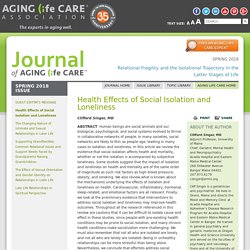
Social isolation, loneliness and physical performance in older-adults: fixed effects analyses of a cohort study. Study design and participants We used data from the English Longitudinal Study of Ageing (ELSA), a nationally representative cohort study of community dwelling adults aged over 50 in England.
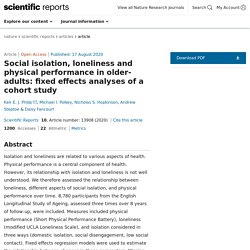
The sample was drawn from households that had previously responded to the Health Survey for England (HSE) in 1998, 1999 or 2001. HSE used a two-stage sampling design consisting of the selection of postcode sectors from a postcode address file and then subsequent selection of postcode addresses from within each postcode sector19. All core participants from wave 2 of ELSA (2004/05—when physical performance was first measured) were included (n = 8,780), and were followed up in waves 4 (2008/09) and 6 (2012/13). We maintained a sample size of 8,780 participants through the waves by imputation of missing data, as described below. Measures Physical performance. How Social Isolation Affects the Brain. Daisy Fancourt was at her home in Surrey in southeast England when the UK government formally announced a nationwide lockdown.

Speaking in a televised address on March 23, UK Prime Minister Boris Johnson laid out a suite of measures designed to curb the spread of COVID-19, including closing public spaces and requiring people to stay home except for exercise and essential tasks. For Fancourt, an epidemiologist at University College London (UCL), the announcement meant more than just a change to her daily life. It was the starting gun for a huge study, weeks in the planning, that would investigate the effects of enforced isolation and other pandemic-associated changes on the British public.
We’re a social species. We really need others to survive.
Physical Health Risks. Cognitive Health Risks. COVID-19 and Social Distancing Measures. COVID-19 and the consequences of isolating the elderly - The Lancet Public Health. As countries are affected by coronavirus disease 2019 (COVID-19), the elderly population will soon be told to self-isolate for “a very long time” in the UK, and elsewhere.
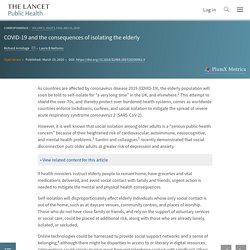
BBCCoronavirus: isolation for over-70s ‘within weeks’. This attempt to shield the over-70s, and thereby protect over-burdened health systems, comes as worldwide countries enforce lockdowns, curfews, and social isolation to mitigate the spread of severe acute respiratory syndrome coronavirus 2 (SARS-CoV-2). However, it is well known that social isolation among older adults is a “serious public health concern” because of their heightened risk of cardiovascular, autoimmune, neurocognitive, and mental health problems.
Social Groups with Higher Risks. Social isolation, loneliness and health in old age: a scoping review - Courtin - 2017 - Health & Social Care in the Community.
Social isolation: The COVID-19 pandemic's hidden health risk for older adults, and how to manage it. As coronavirus cases rise again, it can be hard for older adults to see any end to the need for social isolation and the loneliness that can come with it.
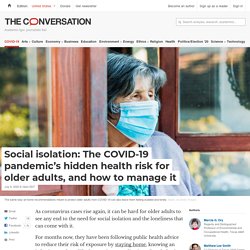
For months now, they have been following public health advice to reduce their risk of exposure by staying home, knowing an infection can have life-threatening complications. But sheltering at home has also meant staying distant from family, friends and the places that kept them active and engaged.
Social isolation and loneliness among older adults in the context of COVID-19: a global challenge. Social isolation is defined as the objective state of having few social relationships or infrequent social contact with others while loneliness is a subjective feeling of being isolated.
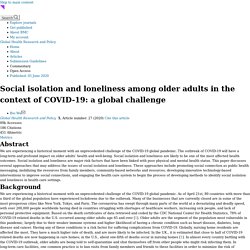
Social isolation and loneliness are serious yet underestimated public health risks that affect a significant portion of the older adult population. In the U.S., approximately one-quarter of community-dwelling older adults are considered to be socially isolated, and 43% of them report feeling lonely [2]. The COVID-19 pandemic is increasing the number of older adults who are socially isolated including both community-dwelling older adults and nursing home residents, as many countries have issued stay-at-home orders and banned visits for nursing home residents. Prior to the disease outbreak, the vast major of community-dwelling older adults actively participated in social activities, such as attending senior centers, churches activities, traveling, and many other social events.
Identification of Socially Isolated Elderly. What Elderly People Can Do To Prevent Social Isolation. What Caregivers Can Do To Prevent Social Isolation In Elderly.






